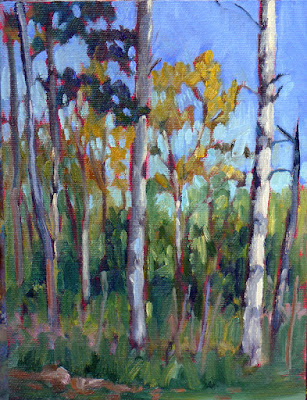My asthma is teaching me life lessons that are applicable to painting and any other heroic endeavor.
 |
| Clary Hill Blueberry Barrens, full sheet watercolor, available. |
My asthma, which is usually quiet, has been kicking up since I had COVID. I find myself stopping to suck air as I climb Beech Hill in the morning.
Beech Hill is no great shakes as hills go, since its summit is only a few hundred feet higher than my house. I climb it every morning, which gives me a good base level of cardiovascular fitness (and around 6000 steps to start my day). I figure that a little cardio work each morning will give better long-term results than killing myself a few times a week at the gym.
 |
| Early Spring on Beech Hill, oil on canvasboard, Carol L. Douglas, 12X16, $1449 framed. |
Painting is like that, too. In their Art & Fear: Observations On the Perils (and Rewards) of Artmaking, David Bayles and Ted Orland make the point that the best art is made by people who do it over and over. A half-hour drawing every morning will yield quiet, positive results that no painting marathon can.
We’ve had a cold winter here in New England. Yesterday, it was -2°F. as we set out. Sensible people don’t go rambling in those temperatures, but rambling is a habit, and habit forces me out the door. In my professional life, I’m in a phase where I’ve spent most days ‘putting out fires’ rather than working on new material. There will always be challenges, but habit alone forces me back into my studio.
 |
| Mountain Path, 11X14, oil on canvasboard, available. |
I’ve started repeating a mantra as my chest tightens: “Don’t look at the hill.” If I look at the distance I still have to climb, the tightness doubles and I have to stop. I know I’m psyching myself out, but I can’t seem to stop it. So, in the steepest parts of my climb, I concentrate assiduously on my footing. It’s better not to contemplate the enormity of what lies before me.
A few weeks ago, a student asked me how long it takes to learn to paint. Because he’s tough, I answered honestly: it takes years. But to focus on that is like looking up at the hill; it makes every step harder.
That dissuades many people from even trying. But time elapses whether or not we’re doing anything useful. It’s easy to fritter away, as all those people who were going to learn second languages during lockdown have learned to their dismay.
 |
| Christmas Eve, 6X8, oil on canvasboard, available. |
I’m planning on walking the length of Hadrian’s Wall in Britain in May. It’s the wall’s 1900th anniversary and Queen Elizabeth’s Platinum Jubilee. Walking across an entire country sounds absurd to an American, but it’s a shorter distance (84 miles) than from my house to the New Hampshire border. However, it will be a series of long days in the company of friends who are all younger than me. And northern England is hilly.
I should be seriously training right now, and instead I’m unable to keep up my usual four-mile-a-day pace. I’ll regret ruining this trip for my companions, so I occasionally wonder if I should just bow out now.
However, I’m old enough to realize the truth in the adage, “Sufficient unto the day is the evil thereof.” Worrying about tomorrow is a great way to stop myself from doing anything today. That’s true of painting or any other heroic endeavor. Instead of panicking, I’ll just challenge myself again this morning. And, lest you worry, I have an appointment with my nurse-practitioner on Friday.





